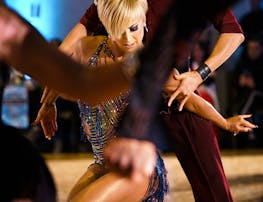Grieving and out of shape, I took up ballroom dancing. It saved my life.

When I discovered ballroom dancing, it literally may have saved my life. I arrived on the dance floor in 2015 at the ripening age of 59. I was fat and had only quit drinking a month earlier. I had spent several years caring for my wife, who died of a rare and bizarre brain disorder, and the stress had left me in bad shape. The two of us had always talked about taking dance lessons but we never got around to it. Seven months after her death, I went to hear some music with a woman from my caregivers' support group. She asked me to dance, and I had to confront the fact that I didn't know how. I decided it was time to learn.
I wandered into Cinema Ballroom in St. Paul intending to learn a few social dances, but that first lesson left my head spinning. When the instructor explained the cost of various packages, it didn't register. All I could say was, "Where do I sign?"
Within a few months, I was taking weekly private lessons and as many group classes as I could swing. I danced two or more hours a day, six to seven days a week. I shed more than 30 pounds. I eventually faced the terror of asking strangers to dance at the ballroom's dance parties. And when my instructor asked me to perform with her in a recital known as a "showcase," I quit my lifelong martial arts studies. I figured it was the only way I could learn the six dances she had in mind. One year later, I entered the Twin Cities Open, the first of my many DanceSport competitions.
My interest in dance actually goes back to grade school and learning about oil painting and artist Edgar Degas. I was fascinated with his romanticized ballerinas, images of human beauty and grace. I read about Vaslav Nijinsky, whose eponymous leaps seemed to break the bonds of gravity. But my first personal experience with dance, in junior high gym class, left me feeling inadequate.
And I am. But it turns out, so is everyone else. A dancer's grace is achieved through hard work and sacrifice. And yet, it produces a high that few other activities match.
There are many styles of dance: ballet, ballroom, tap, tango, slow swing, salsa, cumbia, hip-hop — you get the idea. So what is it about ballroom dancing that keeps me and so many others coming back? First of all, it's doable. I've seen people in their 90s, including one with a cane, dancing socially, and some even compete.
Then there's the social aspect. Ballrooms draw people from all walks of life. Among my friends in the ballroom world are mathematicians, medical doctors, university professors, schoolteachers, students, farmers, engineers and the owner of a steel company. These people have enriched my life beyond measure. When a dancer was injured in a car accident, the Cinema Ballroom community — and that's what it is — rallied to his bedside and provided support until he was released from the hospital.
Formal ballroom dancing involves memorizing choreography, which is good for the brain, and performing to a standard that displays poise, balance, fluidity, timing and, when appropriate, power. All of that must be synchronized with a partner. And whether dancing socially or competitively, it must be done among a sea of other dancers.
Competing can focus the training, and dancing with a professional partner lets you glimpse your best self. Even so, competitions are not for everyone. For one thing, they can be shockingly expensive. While it's fun to go all in for those who can afford it, if you're interested in competing there are ways to cut expenses, and the pros will help you do so.
I mentioned that dancing may have saved my life. After decades of martial arts training, my joints were wearing out. I had a rotator cuff tear (which I just got repaired), no ACL or medial meniscus in my right knee, and arthritis in both wrists. Not long after I started dancing, I suffered a series of kidney stones, bouts of vertigo that nearly sent me through a wall, and a transient ischemic attack, sometimes called a mini stroke. Through it all, I kept dancing. I decided if death was coming, I would rather go out on the dance floor.
Dancing has provided me a new life — and a second career. I began photographing dancers, rekindling a lifelong interest, and started a company that specializes in portraits and dance and athletic photography. With the easing of pandemic restrictions, I'm practicing my dance routines nearly every day, preparing for my next competition.
I regret deeply that I never got around to dance lessons with my wife. After she died, I vowed that when someone asks me to do something new, if I didn't have a good reason to say no, I would say yes. Now I'm asking you: Would you like to dance?
Dan Browning is a retired journalist with a photography business. Reach him at dan@danzantephotography.com



No comments:
Post a Comment